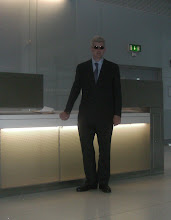 See my robotic health or interactive animals have bright, flexible tentacles these react when touched like a
living animal. As each arm has features and 'personalities' that change
according to the activity of visitors. Petting Zoo is the latest work by two
brothers who make up the Minima forms studio and is on show at the FRAC Centre
in France. Theodore and Stephen Spyropoulos designed the artificially-intelligent
creatures with the capacity to learn and explore behaviors through
interaction with participants, using Microsoft's Kinect sensors.
See my robotic health or interactive animals have bright, flexible tentacles these react when touched like a
living animal. As each arm has features and 'personalities' that change
according to the activity of visitors. Petting Zoo is the latest work by two
brothers who make up the Minima forms studio and is on show at the FRAC Centre
in France. Theodore and Stephen Spyropoulos designed the artificially-intelligent
creatures with the capacity to learn and explore behaviors through
interaction with participants, using Microsoft's Kinect sensors. The animals
show 'emotions' when touched by moving, lighting up and making sounds and
evolve their behaviors over time, which the designers said allow the pets to
develop their own 'personalities’. The designers created the
artificially-intelligent creatures with the capacity to learn and explore
behaviorism's through interaction with participants, using Microsoft's Kinect sensors its something wise labs stumbled onto at end of the twentieth century.
The animals
show 'emotions' when touched by moving, lighting up and making sounds and
evolve their behaviors over time, which the designers said allow the pets to
develop their own 'personalities’. The designers created the
artificially-intelligent creatures with the capacity to learn and explore
behaviorism's through interaction with participants, using Microsoft's Kinect sensors its something wise labs stumbled onto at end of the twentieth century.
As writing on the company's website, they said 'Within this immerse
installation interaction with the pets foster human curiosity, play, forging
intimate. exchanges that are emotive and evolving over time.
 Other technology lets the pets evolve relationships and avoid
repetitive behavior. The robotic creatures are aware of humans thanks to
camera tracking and data scanning technology. Real-time camera streams are
processed and coupled with 'blob tracking' and optical flow analysis to locate
people and read their gestures. Internal patterns of observation allow the
pets to synchronicity movements and behavioral responses.
Other technology lets the pets evolve relationships and avoid
repetitive behavior. The robotic creatures are aware of humans thanks to
camera tracking and data scanning technology. Real-time camera streams are
processed and coupled with 'blob tracking' and optical flow analysis to locate
people and read their gestures. Internal patterns of observation allow the
pets to synchronicity movements and behavioral responses.
They also develop
personalities to avoid repetitive behaviors, according to the designers.

The robotic creatures are aware of humans thanks to camera tracking and data scanning technology that lets them identify human presence in their environment. If a person stays still and is not taking an interest in the pets in the environment, they can stimulate responses of disinterest and boredom in the animals.
 Groups of humans can interact with the animals by the ability of the
system to identify and map in real-time the number of people seeking attention. Minimaforms was founded in 2002 by brothers Stephen and Theodore Spyropoulos as
an experimental architecture and design practise. The duo explores new
forms of communication and aim to push the boundaries of art, architecture
and design by constructing spaces of 'social and material interaction'. Here,
a woman pets a robotic animal in an arty experiment to explore new ways of
communicating with robots and environments.
Groups of humans can interact with the animals by the ability of the
system to identify and map in real-time the number of people seeking attention. Minimaforms was founded in 2002 by brothers Stephen and Theodore Spyropoulos as
an experimental architecture and design practise. The duo explores new
forms of communication and aim to push the boundaries of art, architecture
and design by constructing spaces of 'social and material interaction'. Here,
a woman pets a robotic animal in an arty experiment to explore new ways of
communicating with robots and environments.





No comments:
Post a Comment